In connection with the exhibition currently on view at The Frick Art Museum, Isabelle de Borchgrave: Fashioning Art from Paper, we are presenting a series of stories on a variety of exhibition-related topics.
In this installment. Sarah Hall, chief curator, director of collections, discusses the Frick's installation of Borchgrave's Medici series.
Isabelle de Borchgrave’s impetus for creating her Medici series was based on a desire to recreate the opulent costuming that she saw in Renaissance paintings and frescoes during her visits to Florence. De Borchgrave has said that the Medici series is her most complicated—the voluminous gowns with varied hand-painted decorations simulating silk satin, silk brocade, velvets, and other fabrics also feature applied ornament, complicated bodices, sleeves, and ruffed collars. They required not only time and intricate craftsmanship, but the study of Renaissance and Baroque fashion history (dating from around 1400–1700 CE) in order to understand the structure of garments that are only partially visible in her source images.
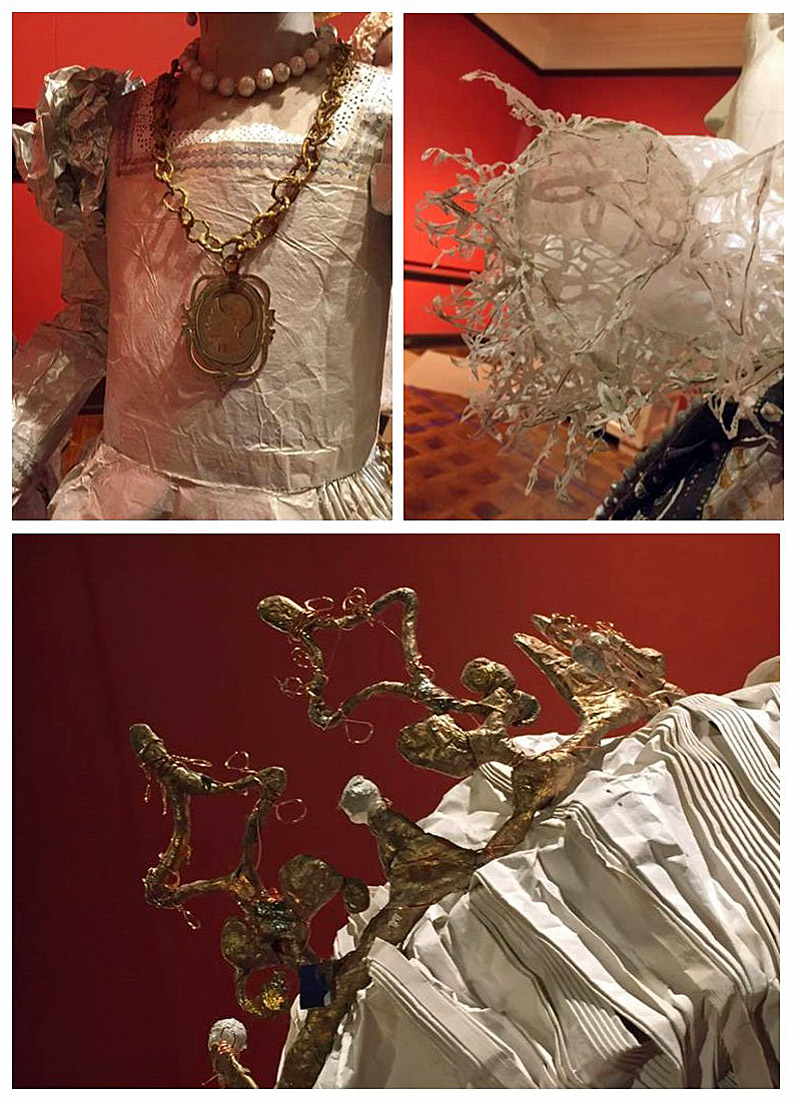
Top left: Detail of costume of Bia de Medici showing necklace with a medallion portrait of her father, Cosimo.
Top right: Detail of costume of Marie de Medici, Queen of France by Isabelle de Borchgrave, with delicate ruffed collar.
Bottom: Detail of costume of Marie de Medici, Queen of France, with intricate twisted paper and wire crown.
When we were doing staff training to prepare the exhibition, I showed a slide titled “Untangling the Medici” with a screenshot of many of the various complicated Medici family trees that you can find online. While the diagrams spider-webbed the screen, I basically said, “I’m not going to go there.” The Medici family, and the study of their lives and impact over the course of their 300-year dynasty (which produced four popes and two queens of France), has been the sphere of many brilliant scholars for many years, and I am not one of them.
That said, 13 of de Borchgrave’s Medici inspired artworks have taken up temporary residence in The Frick Art Museum, and I felt a certain obligation to get to know them as people and not just mannequins.
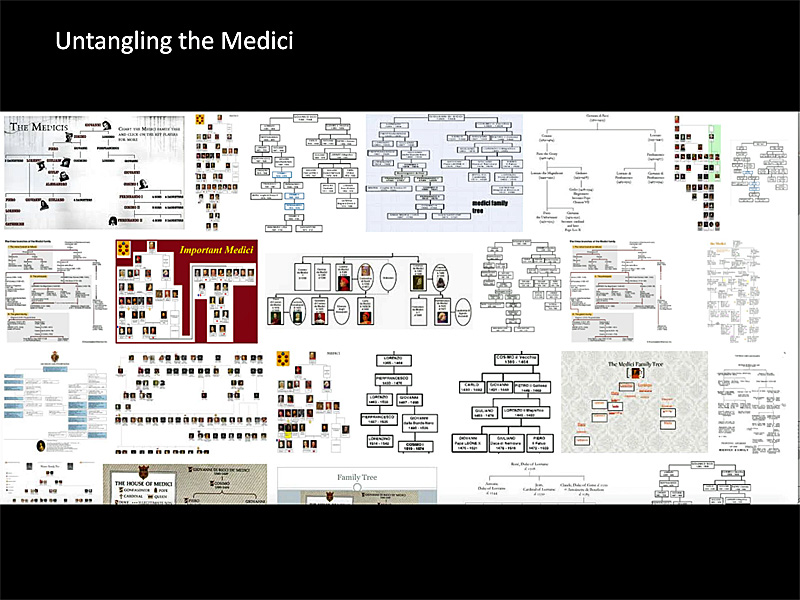
Screen capture of the search for “Medici family tree.”
I approached the group with the primary goal to create clarity for visitors. What’s the right level of biographical and historical information to make this display come together and allow the separate artworks to interact? I considered displaying all of the Medici figures with our Italian painting collection—but quickly abandoned that idea the first time I saw the Medici figures in person. The entire group would have overwhelmed the Frick’s gallery of quiet, reverential devotional paintings. This led to my decision to place the figure of Lorenzo the Magnificent (1449-1492), perhaps the best known of the Medici art patrons, in the Italian gallery, positioned near Florentine paintings that date to his lifetime. I also rewrote label copy to connect to our collection. I put de Borchgrave’s two Botticelli figures in this room as well, because Lorenzo had commissioned the two paintings that were de Borchgrave’s inspiration.
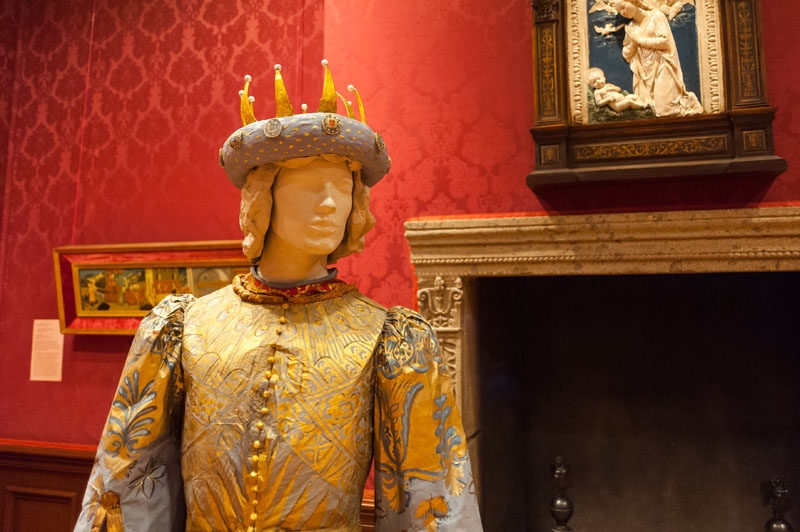
Lorenzo il Magnifico by Isabelle de Borchgrave installed in the Italian Gallery at The Frick Art Museum.
Isabelle de Borchgrave’s portrait of Lorenzo was inspired by a fresco in the Palazzo Medici Riccardi, she described her experience there:
The Chapel of the Magi is just a little room but magnificent with colors—gold, red, green—and the costumes from the paintings depict the most luscious textiles from all over the world. I desired to pull the people out of the paintings and make them standing.
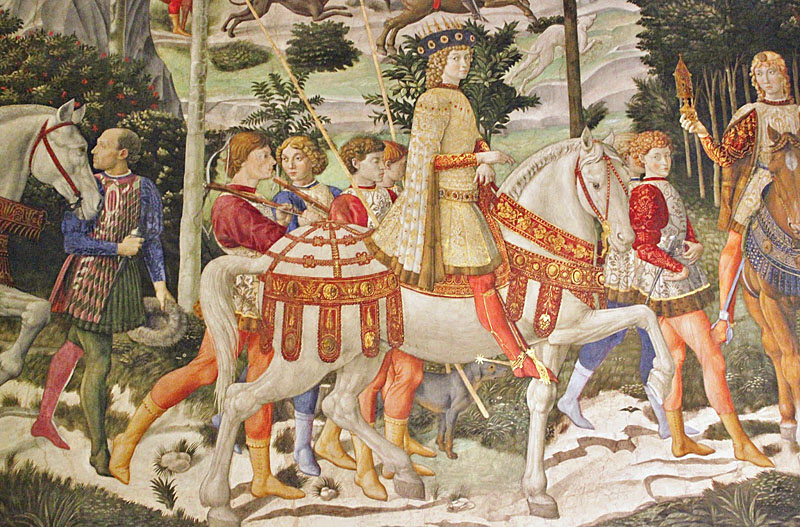
An idealized Lorenzo il Magnifico (born 1449) is depicted riding a white horse in a fresco on the east wall of the Magi Chapel at the Palazzo Medici Riccardi in Florence.
Next came the ten other members of Lorenzo’s extended family. I felt strongly that they should have their own dedicated space—and knew that one of our smaller galleries would be just about the right size. I also knew that, if the Medici figures were organized chronologically, the princess we had commissioned (see my previous blog post) would land right in the middle of the sequence. Although she is not a Medici, Princess Charlotte had served in the court of Marie de' Medici, mother of Louis XIII. This worked perfectly—and allowed the Rubens portrait that was the source for the princess to anchor the center wall of the room. Putting the princess next to the queen also tells a broader story of intermarriage, alliances, and consolidation of power between noble families in Europe. As we arranged the figures in chronology, we wrote label copy that made the family relationships as explicit as possible and indicated which figures formed closer family groups.

Splendor of the Medici section installation in progress at The Frick Art Museum
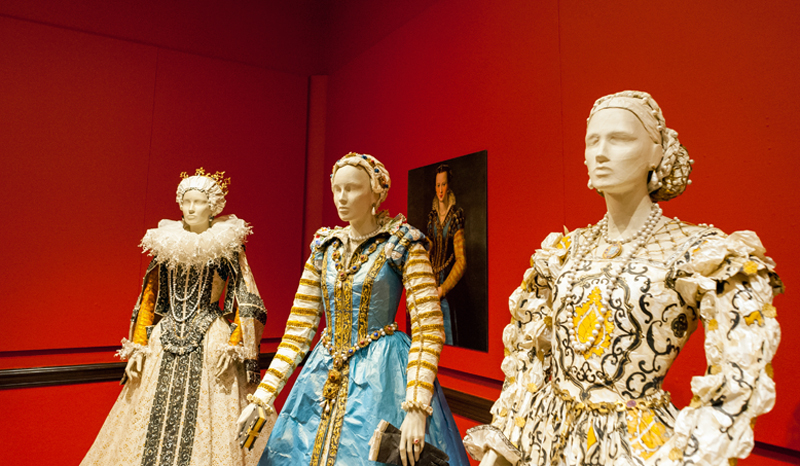
Isabelle de Borchgrave's costumes, Maria de' Medici (left) and Eleanora di Toledo (right)
But it’s mainly about the clothes, and the artistry of Isabelle de Borchgrave, who allows us, for a short time to time travel to this period when the Florentine textile industry was creating spectacular fabrics—some of the finest ever known. From about 1400 to 1600, the silks and velvets created in Florence were exported throughout Europe and the Middle East.
In the Medici series, we see how clothes were a direct reflection of status—yet often contained other messages. They could speak of power, as Cosimo de Medici’s coronation garb does. They could indicate innocence or even personal identity, as the white dress of Bia (Bianca) de Medici does, adorned with a portrait medallion of her father as proof of her Medici parentage. Cosimo’s wife, Eleanor wears a gown featuring a golden pomegranate design, referencing her fertility (aptly chosen, since she and Cosimo had 11 children). The dress in the portrait can also be read as an advertisement for the Florentine silk industry. The Medici portraits therefore, do not only display the wealth of the Medici family but the prosperity, prowess, and power of Florence itself.
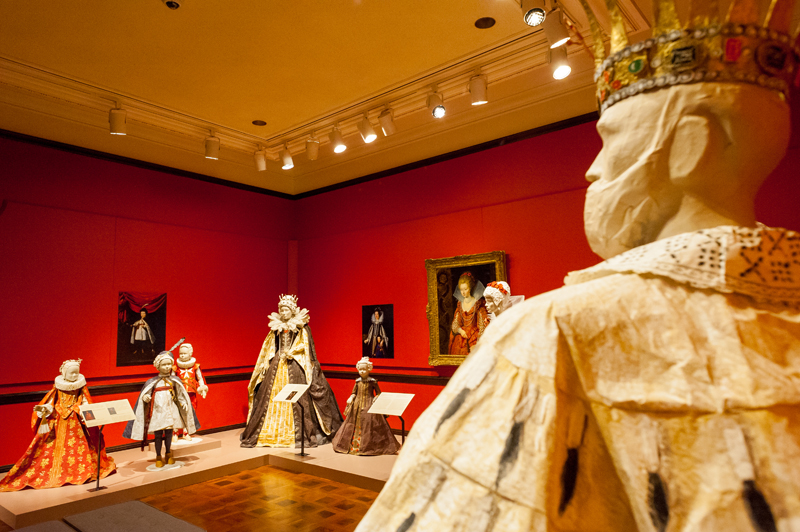
Installation of Isabelle de Borchgrave's Medici costumes at The Frick Art Museum
Isabelle de Borchgrave: Fashioning Art from Paper is on view at The Frick Art Museum through January 6, 2019.
Learn More
Purchase Tickets
Top left: Detail of costume of Bia de Medici showing necklace with a medallion portrait of her father, Cosimo.
Top right: Detail of costume of Marie de Medici, Queen of France by Isabelle de Borchgrave, with delicate ruffed collar.
Bottom: Detail of costume of Marie de Medici, Queen of France, with intricate twisted paper and wire crown.
When we were doing staff training to prepare the exhibition, I showed a slide titled “Untangling the Medici” with a screenshot of many of the various complicated Medici family trees that you can find online. While the diagrams spider-webbed the screen, I basically said, “I’m not going to go there.” The Medici family, and the study of their lives and impact over the course of their 300-year dynasty (which produced four popes and two queens of France), has been the sphere of many brilliant scholars for many years, and I am not one of them.
That said, 13 of de Borchgrave’s Medici inspired artworks have taken up temporary residence in The Frick Art Museum, and I felt a certain obligation to get to know them as people and not just mannequins.
Screen capture of the search for “Medici family tree.”
I approached the group with the primary goal to create clarity for visitors. What’s the right level of biographical and historical information to make this display come together and allow the separate artworks to interact? I considered displaying all of the Medici figures with our Italian painting collection—but quickly abandoned that idea the first time I saw the Medici figures in person. The entire group would have overwhelmed the Frick’s gallery of quiet, reverential devotional paintings. This led to my decision to place the figure of Lorenzo the Magnificent (1449-1492), perhaps the best known of the Medici art patrons, in the Italian gallery, positioned near Florentine paintings that date to his lifetime. I also rewrote label copy to connect to our collection. I put de Borchgrave’s two Botticelli figures in this room as well, because Lorenzo had commissioned the two paintings that were de Borchgrave’s inspiration.
Lorenzo il Magnifico by Isabelle de Borchgrave installed in the Italian Gallery at The Frick Art Museum.
Isabelle de Borchgrave’s portrait of Lorenzo was inspired by a fresco in the Palazzo Medici Riccardi, she described her experience there:
The Chapel of the Magi is just a little room but magnificent with colors—gold, red, green—and the costumes from the paintings depict the most luscious textiles from all over the world. I desired to pull the people out of the paintings and make them standing.
An idealized Lorenzo il Magnifico (born 1449) is depicted riding a white horse in a fresco on the east wall of the Magi Chapel at the Palazzo Medici Riccardi in Florence.
Next came the ten other members of Lorenzo’s extended family. I felt strongly that they should have their own dedicated space—and knew that one of our smaller galleries would be just about the right size. I also knew that, if the Medici figures were organized chronologically, the princess we had commissioned (see my previous blog post) would land right in the middle of the sequence. Although she is not a Medici, Princess Charlotte had served in the court of Marie de' Medici, mother of Louis XIII. This worked perfectly—and allowed the Rubens portrait that was the source for the princess to anchor the center wall of the room. Putting the princess next to the queen also tells a broader story of intermarriage, alliances, and consolidation of power between noble families in Europe. As we arranged the figures in chronology, we wrote label copy that made the family relationships as explicit as possible and indicated which figures formed closer family groups.
Splendor of the Medici section installation in progress at The Frick Art Museum
Isabelle de Borchgrave's costumes, Maria de' Medici (left) and Eleanora di Toledo (right)
But it’s mainly about the clothes, and the artistry of Isabelle de Borchgrave, who allows us, for a short time to time travel to this period when the Florentine textile industry was creating spectacular fabrics—some of the finest ever known. From about 1400 to 1600, the silks and velvets created in Florence were exported throughout Europe and the Middle East.
In the Medici series, we see how clothes were a direct reflection of status—yet often contained other messages. They could speak of power, as Cosimo de Medici’s coronation garb does. They could indicate innocence or even personal identity, as the white dress of Bia (Bianca) de Medici does, adorned with a portrait medallion of her father as proof of her Medici parentage. Cosimo’s wife, Eleanor wears a gown featuring a golden pomegranate design, referencing her fertility (aptly chosen, since she and Cosimo had 11 children). The dress in the portrait can also be read as an advertisement for the Florentine silk industry. The Medici portraits therefore, do not only display the wealth of the Medici family but the prosperity, prowess, and power of Florence itself.
Installation of Isabelle de Borchgrave's Medici costumes at The Frick Art Museum
Isabelle de Borchgrave: Fashioning Art from Paper is on view at The Frick Art Museum through January 6, 2019.
Learn More
Purchase Tickets

